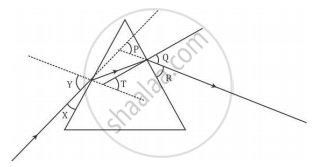Advertisements
Advertisements
प्रश्न
What acts as tiny prisms in the formation of a rainbow?
उत्तर
Raindrops act as tiny prisms in the formation of a rainbow.
APPEARS IN
संबंधित प्रश्न
In the following diagram, the path of a ray of light passing through a glass prism is shown:

In this diagram the angle of incidence, the angle of emergence and the angle of deviation respectively are (select the correct option):
(A) X, R and T
(B) Y, Q and T
(C) X, Q and P
(D) Y, Q and P
State the cause of dispersion of white light
(i) A ray of white light breaks up into its components while passing through a glass prism. Draw a ray diagram to show the path of rays.
(ii) Mark the least deviated colour in your diagram

(iii) Why do different coloured rays deviate differently in a prism?
In which of the following four diagrams is the correct path of a ray of light passing through a glass prism shown ?
If a monochromatic beam of light undergoes minimum deviation through an equiangular prism, how does the beam pass through the prism, with respect to its base?
Draw a labelled diagram: Dispersion of light through a prism.
Answer the following question:
Differentiate between a glass slab and a glass prism. What happens when a narrow beam of
(i) a monochromatic light, and
(ii) white light passes through
(a) glass slab and
(b) glass prism?
What is the cause of the dispersion of white light through a glass prism? Draw a ray diagram to show the path of light when two identical glass prisms are arranged together in an inverted position with respect to each other and a narrow beam of white light is allowed to fall obliquely on one of the faces of the prisms.
Curved mirrors have surfaces that are spherical, cylindrical, parabolic, and ellipsoid.
